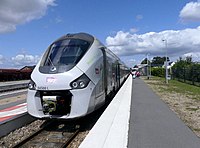
Photo from wikipedia
Abstract LTC (Low Temperature Combustion) has demonstrated abilities to lower diesel engine emissions while achievement of better fuel economy in comparison with conventional combustion. One of the major LTC methods… Click to show full abstract
Abstract LTC (Low Temperature Combustion) has demonstrated abilities to lower diesel engine emissions while achievement of better fuel economy in comparison with conventional combustion. One of the major LTC methods is PCCI (Premixed Charge Compression Ignition) combustion strategy in which high levels of EGR (exhaust gas recirculation) is utilized to reduce overall combustion temperatures and to lengthen the ignition delay. Increase in ignition delay provides time for fuel evaporation and reduces in-homogeneities in the reactant mixture, thus NOx formation from local temperature spikes and Soot formation from locally rich mixtures can be reduced. However, as dilution is increased to the limits, Soot, HC and CO can significantly increase. One of the ways to control these emissions in PCCI combustion is utilizing biodiesel fuel due to its different physical and chemical properties compared to petroleum-based diesel fuel. Hence, in the present work, a numerical study is performed to compare the combustion, performance and emission characteristics of neat biodiesel and diesel fuel surrogates under the condition of PCCI combustion mode in a light-duty, single-cylinder diesel engine by KIVA-CHEMKIN code. The operating conditions are at the engine speed of 2000 rpm and load of 5.5 bar IMEP. Simulations are capable of capturing, not only the bulk combustion characteristics, as well as the first and second-stage combustion processes, but also the details of the important reactive species and emission formation. For both diesel and biodiesel fuels, it has been tried to find optimum cases which are only based on sweep of injection timing and do the comparisons at those optimum states. The results indicate that for both diesel and biodiesel fuels, −30 CAD ATDC SOI timing can be regarded as an optimum SOI timing for the lowest NOx + THC and CO emissions. For the optimum case, NOx, CO, THC, thermal efficiency and ISFC for the biodiesel case are lowered by 13%, 27%, 12%, 9.5% and increased by 6%, respectively compared to the diesel case.
Journal Title: Applied Thermal Engineering
Year Published: 2017
Link to full text (if available)
Share on Social Media: Sign Up to like & get
recommendations!